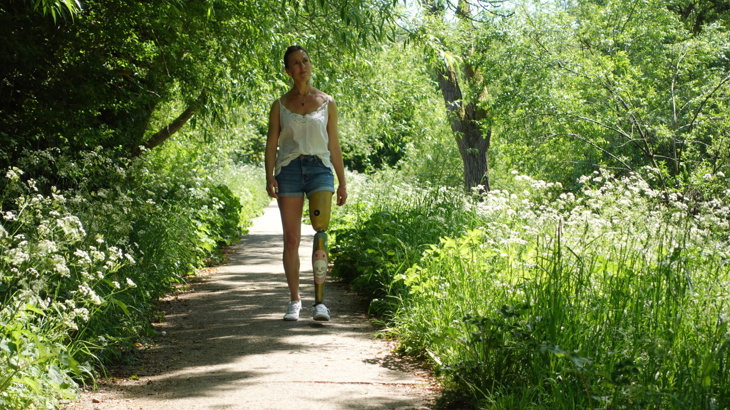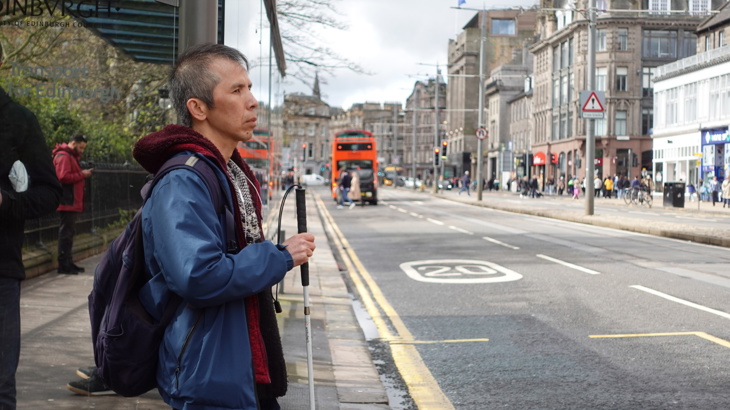Disabled people are in danger of being further excluded in society if future changes to transport do not involve them and address their needs, according to our new report launched today.

Transforming Mobility report argues that legalising the installation of side road zebra crossings would make streets safer and more accessible for disabled people and other users. Credit: Chris Foster/Sustrans
Disabled people are in danger of being further excluded in society if future changes to transport do not involve them and address their needs, according to our new report launched today.
The Transforming Mobility research was led by our policy team, with Transport for All – the disabled-led charity working to ensure all disabled people can travel easily and confidently.
The project was funded by the Motability Foundation.
It found that half (48%) of disabled people think government is not doing enough to ensure accessibility is a priority.

Transforming Mobility: Including disabled people in transport planning
Transforming Mobility is a Sustrans project with Transport for All, funded by the Motability Foundation, exploring how to better include disabled people in transport planning.
Legalising side road zebra crossings is one of five big ideas in the report, supported by disabled people, that would improve safety and accessibility on streets, and benefit everyone.
The report includes findings from our 2024 survey of 1,107 disabled people across the UK, carried out by More in Common, and workshops with disabled people in Birmingham, Edinburgh, and Oxford.
The survey found that 72% of disabled people support giving greater priority and investment to low-cost solutions, like side road crossings.
By law, all zebra crossings must currently include belisha beacons, yellow flashing lights at either end of a crossing, and zig-zag approach markings.
Side road zebras, commonly used across Europe, do not include beacons or zig-zag markings.
This ensures they can be used at a side road junction, are quick to install and much cheaper.
A two-year trial of side road zebra crossings in Manchester found that drivers give way 65% more times than when the road markings are not present.
Local and regional governments across the UK are developing visionary plans to transform the way people move and better connect transport systems.

Karina lives in Oxford, and is one of three people featured in the report, who highlights her experience and views about improving transport for disabled people. Credit: Tom Hughes/Sustrans
Four other big ideas to improve transport for disabled people
- Rebalance our streets
Prioritising through traffic on some roads while calming others can make journeys quicker for buses and cars. Nearly two-thirds of disabled people back councils setting clear plans for how streets are used. - Free up public space
Reducing unnecessary visitor parking creates room for benches, trees and wider pavements. Only 22% of disabled people oppose cutting on-street parking, excluding disabled bays. - Create mobility hubs
Join up walking, wheeling and cycling with buses, trams and trains in one place. 81% of disabled people want smoother, simpler connections between modes. - Fund access panels
Pay disabled people to help shape local transport plans. Scotland is already doing it. 65% support giving councils the funding to follow suit.

Joe in Edinburgh is completely blind. "Some traffic lights are quite near the wall and some are installed quite near the road, so I usually need to ask a pedestrian when I want to cross the road. Make it standard." Credit: Tom Hughes/Sustrans
Tim Burns, Head of Research at Sustrans, said:
“The next ten years will see exciting changes in how we move around our cities, as local authorities respond to the UK’s economic, health and environmental challenges with visionary transport plans.
To be truly transformative, these plans need strong local leadership and must put disabled people at their heart.
We know disabled people face greater barriers to getting around and accessing the things they need to live well – while also wanting to travel more sustainably.
Our report highlights tried and tested ideas, increasingly being adopted across the UK. Disabled people want transport to change.
When disabled people are represented, the outcomes are better for everyone.”
Dr Ruth Cumming, Senior Research Officer at Transport for All, said:
“We all need the freedom to travel – for work, for school, for shopping – and to make those journeys easily and safely.
Disabled people are often blocked from that. Including disabled people as experts in transport and urban planning ensures our requirements are built into developments, creating streets, communities and cities that we can all use and enjoy.”





